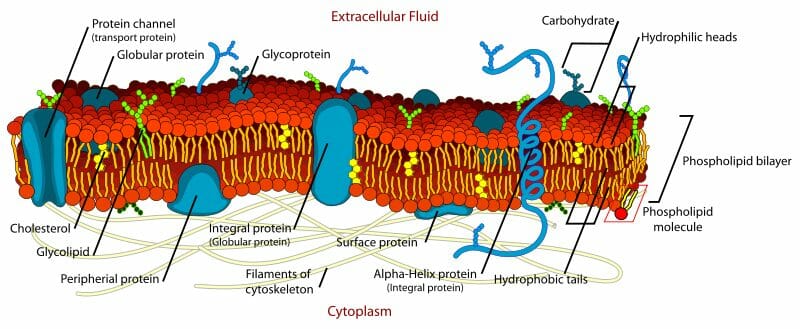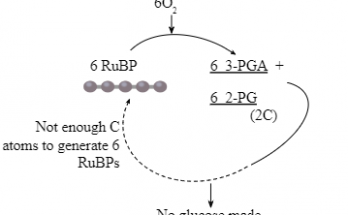Animal Cell Membrane (Plasma Membrane)
Animal cell membrane, also called the plasma membrane, is a thin, semi-permeable layer that surrounds and encloses the contents of an animal cell.
Animal cell membrane is made up of a lipid bilayer, phospholipids and cholesterol. These components act as a barrier to separate the cell from its environment. The membrane also contains various types of proteins, receptors, enzymes, and transporters, which plays an important role in ommunication,regulation of substances entering and leaving the cell and transport between the cell and its environment.
Also Check – 11 Difference between Cell Wall and Cell Membrane (Plasma Membrane)
Also Check – Cell Organelles – The Complete Guide
Animal Cell Membrane (Plasma Membrane) – Structure and Composition

- Cell membrane in Animal Cell is a thin, selectively permeable barrier that surrounds the cell.Structure of the Animal cell membrane is explained by the fluid mosaic model. According to this model the membrane is a fluid structure that is composed of a variety of different components that are constantly moving and changing. This fluidity allows the membrane to respond to changes in the environment and to perform a wide range of functions.
- The membrane is composed of a lipid bilayer . It is made up of two layers of phospholipid molecules. The phospholipid molecules are arranged with their hydrophobic (water-fearing) tails facing each other and their hydrophilic (water-loving) heads facing outwards.
- The phospholipids in the lipid bilayer are arranged in such a way that the hydrophobic tails face each other, creating a barrier that prevents the free movement of water-soluble molecules across the membrane.
- This lipid bilayer acts as a barrier that prevents the free movement of molecules between the inside and outside of the cell. It allows the cell to control the movement of materials like nutrients and waste products in and out of the cell.
- Cholesterol molecules are also present in the lipid bilayer. It helps to increase the fluidity of the membrane by reducing the packing of the phospholipids. In this way it maintains the stability of the lipid bilayer and prevents it from becoming too rigid.
- Animal cell membrane is also composed of a variety of proteins . They are embedded in the lipid bilayer. Proteins play a variety of roles in the cell membrane. It provides structural support, allows specific molecules to move in and out of the cell and allow the cell to interact with other cells and its environment.
- Some proteins are not embedded in the lipid bilayer but are associated with the surface of the animal cell membrane. These peripheral proteins can act as enzymes; they can even bind to other molecules to form complexes that perform specific functions.
- The animal cell membrane is constantly being remodeled and repaired to ensure that it remains functional and effective in protecting the cell and regulating its interactions with the environment.
Also Check – Types of Transport Across Cell Membrane
Also Check – What would happen if the Plasma Membrane Ruptures or Breakdown?
Animal Cell – Cell Membrane ( Plasma Membrane) Functions
Few Important Functions of Cell Membrane ( Plasma Membrane) are as follows –
- Selective permeability – Cell membrane (Plasma Membrane) allows certain molecules and ions to pass through while preventing others from entering the cell.
- Maintain cell shape – Cell membrane (Plasma Membrane) provides structural support and helps maintain the shape of the cell.
- Communicate with other cells- Cell membrane (Plasma Membrane) allows for communication between cells by the exchange of chemical signals and the formation of specialized cell-cell junctions.
- Cell recognition – Cell membrane (Plasma Membrane) contains molecules that allow cells to recognize each other and interact with each other.
- Transport of molecules – Cell membrane (Plasma Membrane) is involved in the transport of molecules and ions across the membrane through active or passive transport mechanisms.
- Regulation of Enzyme – Cell membrane (Plasma Membrane) contains enzymes that catalyze chemical reactions and regulate the flow of molecules into and out of the cell.
- Signal transduction – Cell membrane (Plasma Membrane) contains receptors that can detect and respond to chemical signals which initiate signal pathways within the cell.
- Protection and defense – Cell membrane (Plasma Membrane) acts as a barrier by protecting the cell from harmful substances. It also provides defense against pathogens.
- Energy production – Cell membrane (Plasma Membrane) is involved in energy production through the process of oxidative phosphorylation in the mitochondria.
- Metabolic processes – Cell membrane (Plasma Membrane) is involved in many metabolic processes, such as the synthesis and breakdown of molecules and the regulation of enzyme activity.
- Cell adhesion – The cell membrane is involved in the attachment of cells to each other and to the extracellular matrix, allowing for the formation of tissues and organs.
Did you find this article helpful? We’d love to hear your thoughts and suggestions in the comments!
Also Check – Mitosis In Plant Cell and Animal Cell- Differences and Similarities
Also Check – What are the Similarities between Plants and Animals Cells?


2 Comments on “Animal Cell Membrane (Plasma Membrane) – Structure , Composition and Functions”